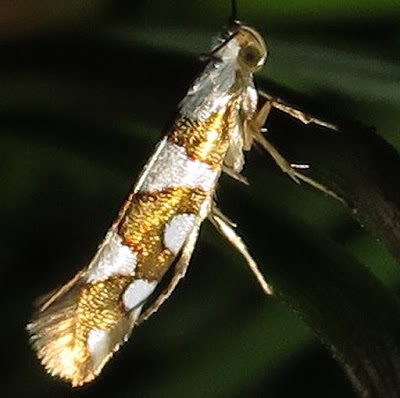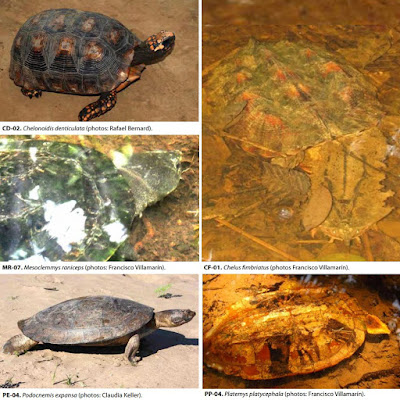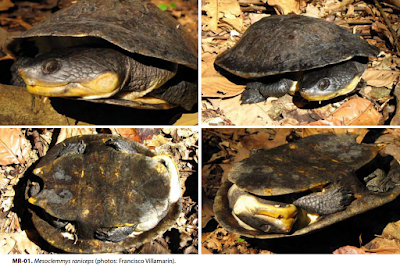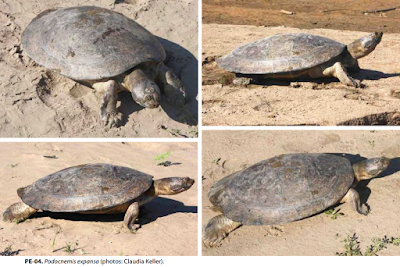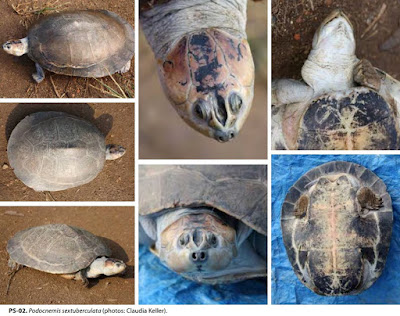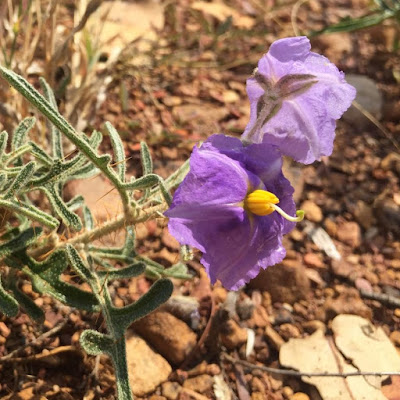[Most Recent Entries] [Calendar View]
Friday, July 14th, 2017
| Time | Event | ||||||
| 2:36a | [Entomology • 2017] Review of the Genus Argyresthia Hübner, [1825] (Lepidoptera: Yponomeutoidea: Argyresthiidae) from China, with Descriptions of Forty-three New Species Abstract The Chinese fauna of Argyresthia Hübner, [1825] included by 14 described species prior to this study. In the present paper we describe 43 new species and record seven species new to China. We also recognized six known Chinese species based on the available specimens; eight species previously reported for the fauna, but without available specimens for examination, are systematically placed in their relevant positions. The total species number of Argyresthia in China is brought to 64. The new species include: A. (Blastotere) aureola, sp. nov., A. (B.) sporadolepis, sp. nov., A. (B.) cineretra, sp. nov., A. (B.) affinicineretra, sp. nov., A. (B.) albaureola, sp. nov., A. (B.) densa, sp. nov., A. (B.) punctireticulata, sp. nov., A. (B.) dolichocoremata, sp. nov., A. (B.) longipenella, sp. nov., A. (Argyresthia) biloba, sp. nov., A. (A.) minutilepidota, sp. nov., A. (A.) flavifusca, sp. nov., A. (A.) trigonophylla, sp. nov., A. (A.) chiotorna, sp. nov., A. (A.) hirsuta, sp. nov., A. (A.) papillata, sp. nov., A. (A.) acuminata, sp. nov., A. (A.) curvativa, sp. nov., A. (A.) atomata, sp. nov., A. (A.) orthocera, sp. nov., A. (A.) cardiopetala, sp. nov., A. (A.) mala, sp. nov., A. (A.) longa, sp. nov., A. (A.) decurtata, sp. nov., A. (A.) minutisocia, sp. nov., A. (A.) scalprata, sp. nov., A. (A.) grammosacca, sp. nov., A. (A.) campylotropa, sp. nov., A. (A.) punctuata, sp. nov., A. (A.) chlorella, sp. nov., A. (A.) triangulata, sp. nov., A. (A.) subzonata, sp. nov., A. (A.) basistriata, sp. nov., A. (A.) longalbella, sp. nov., A. (A.) umbrina, sp. nov., A. (A.) umbrinistrigata, sp. nov., A. (A.) surrecta, sp. nov., A. (A.) lanosa, sp. nov., A. (A.) lata, sp. nov., A. (A.) cuprea, sp. nov., A. (A.) aurilata, sp. nov., A. (A.) convexa, sp. nov., and A. (A.) ellipsoidea, sp. nov. The newly record species include: A. (A.) pygmaeella ([Denis & Schiffermüller], 1775), A. (A.) retinella Zeller, 1839, A. (A.) angusta Moriuti, 1969, A. (A.) alpha Friese & Moriuti, 1968, A. (A.) beta Friese & Moriuti, 1968, A. (A.) kaoyaiensis Moriuti, 1982, and A. (A.) dislocata Meyrick, 1914. The male of A. (A.) trochaula Meyrick, 1938, and the male and female genitalia of A. (A.) aphoristis Meyrick, 1938 and A. (A.) dislocata are described for the first time. The misidentified species A. (A.) assimilis Moriuti, 1977 in China is described as A. (A.) mala, sp. nov. Argyresthia cryptomeriae Yang, nomen non rite publicatum, is validated as Argyresthia anthocephala Meyrick, 1936. Keys to the subgenera and to the Chinese species with available specimens are provided. Photos of adults and male and female genitalia are provided for all the examined species except two from Taiwan. Field photographs and biological information are provided where available. Five DNA barcode sequences of the two new species, A. (A.) surrecta, sp. nov. and A. (A.) lanosa, sp. nov., are provided for association of the sexes. Keywords: Coelenterata, Argyresthia, Blastotere, DNA barcoding, new record, new species Tengteng Liu, Shuxia Wang and Houhun Li. 2017. Review of the Genus Argyresthia Hübner, [1825] (Lepidoptera: Yponomeutoidea: Argyresthiidae) from China, with Descriptions of Forty-three New Species. Zootaxa. 4292(1); 1-135. DOI: 10.11646/zootaxa.4292.1.1 | ||||||
| 7:59a | [Herpetology • 2017] Checklist of Chelonians from the upper Madeira River and the lower Madeira-Purus interfluvium (Brazilian Amazon), including A Range Expansion for Podocnemis sextuberculata Cornalia, 1849 Abstract We present data on occurrence of chelonians for the Madeira River (southwestern Amazon, Brazil). Sampling was undertaken along the BR-319 Highway in the Madeira-Purus interfluvium and along a 125‑km stretch of the upper Madeira River. Findings were contrasted with a checklist of species expected to occur in the region according to current distribution maps, and with literature data for the Madeira subbasin. Out of 12 expected species, we recorded five in the Madeira-Purus interfluvium (three other species were registered by other recent voucher-based studies in the region), and eight species in the upper Madeira region. Podocnemis expansa (Schweigger, 1812) and P. unifilis Troschel, 1848 occurred below and inbetween the upper Madeira rapids. Podocnemis sextuberculata Cornalia, 1849 had its range extended by over 700 km, but may be limited upriver by the rapids. Mesoclemmys gibba (Schweigger, 1812) and M. raniceps Gray, 1855 occurred sympatrically along the river. Chelonian diversity along the lower and upper Madeira appears to be complementary. Keywords: Chelonoidis; Chelus; conservation monitoring; Neotropics; Platemys; river dams
Claudia Keller, Francisco Villamarín, Rafael Bernhard and Daniely Félix da Silva. 2017. Checklist of Chelonians from the upper Madeira River and the lower Madeira-Purus interfluvium (Brazilian Amazon), including A Range Expansion for Podocnemis sextuberculata Cornalia, 1849. Check List. 12(4); 1937-1941. DOI: 10.15560/12.4.1937 | ||||||
| 11:08a | [Botany • 2017] Solanum jobsonii • A Novel Andromonoecious Bush Tomato Species from A New Australian National Park
Abstract A new species of Solanum from the Australian “andromonoecious bush tomato clade” of Solanum subgenus Leptostemonum is described. Solanum jobsonii Martine, J.Cantley, & L.M.Lacey, sp. nov. is part of the S. eburneum Symon species group. It most closely resembles S. eburneum and S. watneyi Martine & Frawley of the northwestern part of the Northern Territory, but is separated geographically from them by the Sturt Plateau. Morphometric analyses show that S. jobsonii differs statistically from S. eburneum, S. watneyi, and S. diversiflorum F.Muell. – a similar species in habit and leaf characters – in several key reproductive and vegetative characters. We provide morphometric evidence for the recognition of S. jobsonii, a complete description, a table of comparisons within its species group, and a map showing species group distributions. One of the first new species to be described from Limmen National Park (established 2012), S. jobsonii is a testament to the value of designating and protecting public lands, as well as supporting science relating to them. Keywords: Limmen National Park, Northern Territory, Solanum watneyi, Solanum eburneum, Solanum diversiflorum, Solanum jobsonii, Peter Jobson, andromonoecy, national parks, public lands, Australia Solanum jobsonii Martine, J.Cantley, & L.M.Lacey, sp. nov. Diagnosis: With affinity to Solanum eburneum, Solanum watneyi, and Solanum diversiflorum, but differing by the involute corolla margins, deeply dissected leaves with 6–12 lobes and smaller creamy-yellow fruits. Etymology: The specific epithet of “jobsonii” is selected to honor Peter Jobson, Senior Botanist at the Northern Territory Herbarium at Alice Springs, an expert on the Northern Territory flora and the leader of the 2016 expedition to collect this and numerous other Solanum taxa with the authors. L. Mae Lacey, Jason T. Cantley and Christopher T. Martine. 2017. Solanum jobsonii, A Novel Andromonoecious Bush Tomato Species from A New Australian National Park. PhytoKeys. 82; 1-13. DOI: 10.3897/phytokeys.82.12106 Newly established, a national park in Australia unveils a new plant species http://bit.ly/2tXTPRq via @Pensoft @EurekAlert |
| << Previous Day |
2017/07/14 [Calendar] |
Next Day >> |
